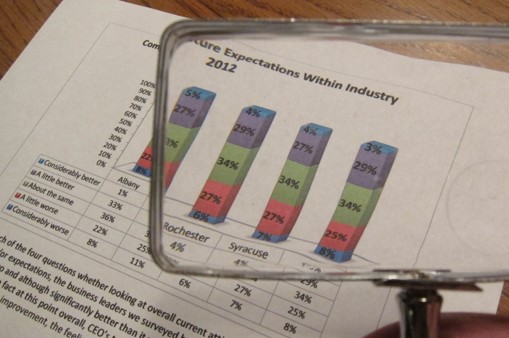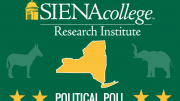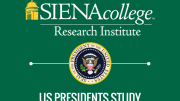First Annual Survey of Pennsylvania Business Leaders
1/26/10
Summary of Findings
Summary
The First Annual First Niagara/Siena College Research Institute Survey of Pennsylvania Business Leaders shows that today more CEO’s are optimistic than pessimistic about the state economy in 2010. CEO’s remain concerned and, as a whole, cautious. But, a growing percentage see an increasingly bright future and, despite worries about adverse economic conditions and governmental regulation, are going about the business of business. Still, only those that are most confident predict an uptick this year in profits, or hiring. Overall, the CEO’s of Pennsylvania know that they have withstood an epic downturn and now although economic conditions and governmental regulation remain challenging, a majority are more optimistic than they were and they expect 2010 to be a better year.
This survey reports data from 755 corporate leaders drawn from Service (25%), Manufacturing (17%), Retail (16%), Engineering/Construction (13%), Wholesale/Distribution (13%), Food/Beverage (7%) and Financial (5%). In order to quickly make sense of how these CEO’s feel about the economy, their place within it and the conditions they expect for the coming year, the Siena College Research Institute has developed an index of Pennsylvania Business Leaders from the data in this survey. If equal numbers of CEO’s have positive and negative perceptions of the current conditions and balanced expectations for the general economy as well as for the present condition of and future for their industry, the overall index would be 100.
Business Leader Confidence
The Index of Pennsylvania Business Leaders simultaneously measures and reports CEO’s perception of their current and future assessment of the state business conditions as well as how those conditions have and will impact their industry.
The overall Index of Pennsylvania Business Leaders is measured at 99.6, thirteen points higher than that of Upstate New York. The Index rests right at the 100 mark at which equal percentages of CEO’s are both optimistic and pessimistic about economic conditions in their industry and across the state. The current index component that assesses business conditions today as compared to six months earlier is now 82.3, 4.2 points higher than Upstate New York, and the future component that measures expectations for the coming year is 117.0 more than twenty-two points above New York’s number.
Forty percent of CEO’s continue to say that business conditions have worsened in Pennsylvania over the last half of 2009 while 26 percent feel as though the economy has already improved. Forty-six percent of CEO’s of private, for-profit companies with sales between $5 million and $200 million in Allentown, Erie, Harrisburg, Lancaster, Philadelphia, Pittsburgh, Reading, Scranton and York expect better economic conditions in Pennsylvania next year compared with 25 percent that anticipate worsening conditions.
The overall Index of Business Leader Confidence is higher in the Philadelphia/Allentown region at 98.7 (80.6 current, 116.8 future) than it is in the Pittsburgh/Erie region at 94.0 (77.0 current, 111.0 future). Individual industry overall index numbers were led by Financial (125.0) followed in order by Retail (102.2), Manufacturing (101.6), Wholesale/Distribution (101.0), Service (95.8), Engineering/Construction (91.9), and Food/Beverage (90.5).
Based upon CEO’s responses to the four key index questions, the study identifies three distinct groups of business leaders today in Pennsylvania. Thirty-five percent of CEO’s report being able to currently thrive and are strongly optimistic about the future. Forty percent of CEO’s acknowledge being seriously impacted by recent economic conditions, but they tend to feel as though things are beginning to improve and, as a group, now have a future confidence level of 118.0. The remaining 25 percent have been very seriously affected by the economy and believe that economic conditions will worsen in both Pennsylvania and their industry before getting better.
Revenues, Profits and Labor Force
Thirty-nine percent of CEO’s anticipate increasing revenues during 2010 as compared to only 23 percent that expect less revenue this year. Thirty-two percent anticipate increasing profitability this year while a slightly smaller number, 30 percent, continue to expect profits to decline.
Despite increasing confidence and growing expectations of higher revenues and profits, fixed asset acquisition plans are at just 40 percent. Of those that do anticipate asset acquisitions, 50 percent plan to use internally generated funds as opposed to either borrowing from a financial institution (32%) or private equity (10%).
Twenty-one percent of business leaders expect to at least moderately increase their workforce in 2010. While 65 percent intend to have their workforce remain the same, 13 percent plan on decreasing their labor force.
Concentrations and Challenges
While 2009 in Pennsylvania was a year of caution, highlighted by cost cutting and survival among these small and medium sized companies, today a growing number of CEO’s are becoming more focused on growing the market for their products and services. Market growth as a top profit enhancement strategy is cited by 40 percent today. A lesser percentage of CEO’s, 36 percent, continue to put cost reductions first. Optimistic companies tend to target growing sales while the more pessimistic companies still primarily look to cost cuts as a business strategy.
The number one concern among Pennsylvania business leaders is governmental regulation (25%), followed by adverse economic conditions (23%) and taxation (10%). Health care was mentioned by 72 percent but only 9 percent see it as their main concern.





